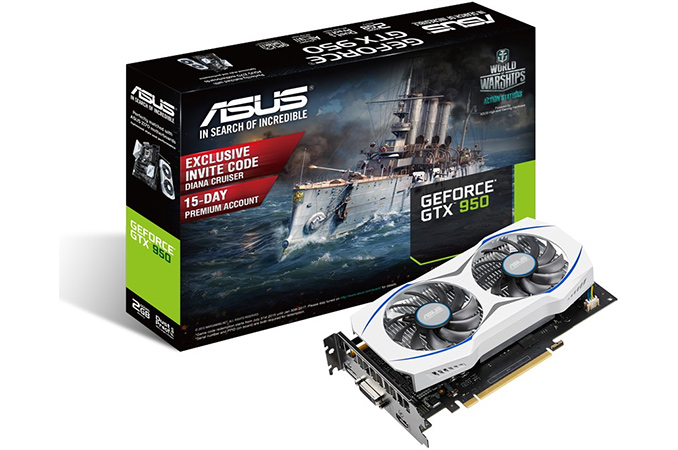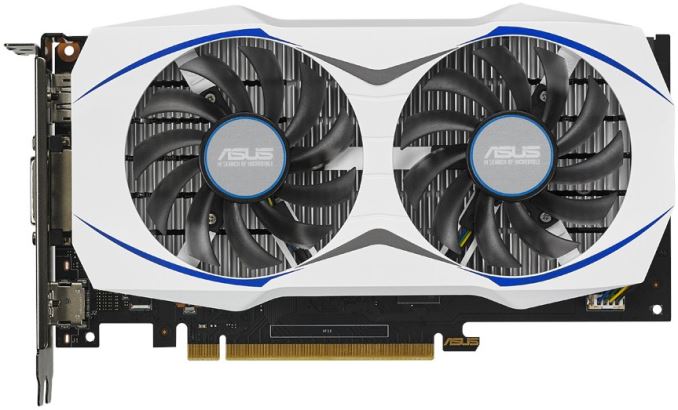ASUS Unveils 75W GeForce GTX 950 Graphics Card; Powered Entirely By PCIe Slot
by Anton Shilov on March 7, 2016 2:00 PM EST
ASUS has quietly introduced its new video card based on the NVIDIA GeForce GTX 950 GPU with a 75W power limit. By virtue of a lower power limit, this newer design does not require a 6pin PCIe auxiliary power connection and can be used to upgrade even basic PCs. Surprisingly, despite the lowered TDP, the ASUS GTX950-2G card features typical clock-rates and other specificaitons one would expect from a GeForce GTX 950.
The sub-75W video card market is an important one, as many desktop PCs supplied by well-known brands lack even basic upgrade capabilities. To cut-down their costs and improve cable management inside their systems, PC makers sometimes reduce the number of power connectors to a minimum they need to build their systems. As a consequence, it gets impossible to add a new hard drive to such computers, or install a higher-performance graphics card due to lack of necessary additional power connectors inside the box.
When NVIDIA designed its Maxwell architecture years ago, the company put a lot of effort into improving relative energy efficiency of its then forthcoming GPUs and into cutting their absolute power consumption as well. As a result, the first Maxwell-based GPU, GM107, consumed only up to 60W even in its most powerful desktop configurations (i.e., GeForce GTX 750 Ti) and was widely used inside notebooks. The majority of GeForce GTX 750 Ti video cards did not require any additional power connectors and could be used to upgrade any PC because any PCIe x16 slot can provide up to 75W of power.
The more advanced GM206 GPU, based on the second-generation Maxwell architecture, has a TDP of up to 120W, which means that video cards based around it have required additional power. As a result, the GeForce GTX 950 and the GeForce GTX 960 video cards are not as OEM PC-friendly because they require one 6-pin PCIe auxiliary power connector. Nonetheless, ASUS has been able develop a GeForce GTX 950 video card that can be installed into almost any PC with sufficient space inside because its power consumption is just 75W.
The ASUS GTX950-2G comes with 2 GB of GDDR5 memory clocked at 6.6 Gbps, a dual-slot dual-fan cooling system with an aluminum heatsink, one DVI connector, one HDMI 2.0 port and one DisplayPort output. ASUS did not lower frequency of the GPU and did not alter its configuration, though as we've seen with past attempts to produce lower power SKUs, it's likely that this card has a reduced hard power limit to stay under 75W and may be more likely to power-throttle as a result. The GPU features 768 stream processors, 48 texture units, 32 ROPs as well as a 128-bit GDDR5 memory interface. It can work at 1051 MHz base clock and at up to 1128 MHz in boost mode (when OC mode is enabled).
Perhaps the most interesting aspect of this video card is that thanks to the underlying GM206 GPU, it's the first sub-75W card to gain full hardware-accelerated decoding and encoding of H.265 (HEVC) video, and it fully supports HDCP 2.2 content protection over HDMI 2.0. This will likely make the ASUS GTX950-2G a popular choice for HTPCs as a result. Conversely, due to low-power nature of the graphics adapter, the ASUS GTX950-2G may not be the best overclocker. For those, who would like to push a GeForce GTX 950 to the limits, ASUS offers its ECHELON-GTX95-O2G and the GTX950-2GD5 video cards that have power and cooling headroom as well as components with enhanced durability (the ECHELON model).
| NVIDIA Video Card Specification Comparison | ||||||
| ASUS GTX950-2G | Ref GTX 950 | Ref GTX 960 | Ref GTX 750 Ti | |||
| CUDA Cores | 768 | 1024 | 640 | |||
| Texture Units | 48 | 64 | 40 | |||
| ROPs | 32 | 16 | ||||
| Core Clock | 1026MHz 1051MHz (OC) |
1024MHz | 1126MHz | 1020MHz | ||
| Boost Clock | 1190MHz 1228MHz (OC) |
1188MHz | 1178MHz | 1085MHz | ||
| Memory Clock | 6.6Gbps GDDR5 | 7Gbps GDDR5 | 5.4Gbps GDDR5 | |||
| Memory Bus Width | 128-bit | |||||
| VRAM | 2GB | 2GB/4GB | /2GB | |||
| TDP | 75W | 90W | 120W | 60W | ||
| Architecture | Maxwell 2 | Maxwell 1 | ||||
| GPU | GM206 | GM107 | ||||
| Transistor Count | 2.94B | 1.87B | ||||
| Manufacturing Process | TSMC 28nm | TSMC 28nm | ||||
| Launch Date | 03/16/16 | 08/20/15 | 01/22/15 | 02/18/14 | ||
| Launch Price | unknown | $159 | $199 | $149 | ||
The ASUS GTX950-2G graphics card is listed at ASUSTeK’s web-site, but is not yet available for sale anywhere. The price of the product will remain a mystery for now, but I do not expect it to be significantly higher than NVIDIA’s MSRP for the GeForce GTX 950 — $159. Meanwhile the card also qualifies for ASUS's ongoing World of Warships promo program, and as a result comes with a code for the game's Diana Cruiser along with 15 days premium credit for a new account.
UPDATE: ASUS has also added the Mini-GTX 950 2G into its linep. The card comes in mini-ITX form-factor, consumes up to 75W and does not require external PCIe power.
Source: ASUS via PC Perspective.
















38 Comments
View All Comments
darkgreen - Monday, March 7, 2016 - link
Hrrrm... at 75 Watts why does it need the huge aluminum block and twin fans? I have a couple 75W (much lower performance) cards and they are passive cooled, albeit with heat pipes and impressive cooler blocks. Still, TWO fans? To crack the HTPC market one expects they would have tried to take advantage of that lower power to make it silent.meacupla - Monday, March 7, 2016 - link
because it's a cheap, huge aluminum block that isn't as efficient as heatpipe heatsinks are at dissipating heat.Speculation, but it's probably quiet.
DanNeely - Monday, March 7, 2016 - link
I wouldn't be surprised if part of why it has so large a heat sink is because one of the places they cut power draw was to use less powerful fans; making it more dependent on the ability of a large heatsink to passively dissipate more of the load. Using a 2 fan design instead of a blower probably is the same thing again; blowers require a much higher RPM (and power eating as a result) fan to keep temps under check. Also, it might just be the pictures, but it looks like the cooler might be using a solid slab of metal with fins on top cooler as opposed to the open fins and heatpipe design in higher end models. If so, I'd guess it's probably cost driven.azazel1024 - Tuesday, March 8, 2016 - link
The lower the temperature of a transistor, the lower the power required to switch it. It has been a long time since I found the research paper, but if memory serves the general power consumption difference between 40C and 90C is about a 10% increase in power consumption. I doubt Asus is going to the extreme to cut power consumption, but a cooling solution that results in 10-20C lower GPU temperatures could be cutting power consumption a couple of watts helping it to stay under the 75w cap.Flunk - Monday, March 7, 2016 - link
Same reason you can get a Geforce 750TI with a giant heatpipe cooler with double fans even thought it just requires a tiny heatsink and fan, marketing.bigboxes - Monday, March 7, 2016 - link
No. You have a giant heatpipe cooler with double fans so that the fans rarely spin up unless you are pushing the card. It's about quiet. There's always the cheaper version for people that don't care about noise/temps (i.e. you).Flunk - Monday, March 7, 2016 - link
I actually own a 750 TI, it's nearly inaudible. A 60Watt card doesn't need a bit heatsink but I see that there is a sucker born every minute. Just like those people who buy 4GB Geforce 720s.Flunk - Monday, March 7, 2016 - link
It also doesn't exceed 60C on load and I have it overclocked as far as the power limit will allow.bigboxes - Monday, March 7, 2016 - link
My MSI GTX 950 Gaming 2G is rated at 90W. I use it in my HTPC where silence is of value. Of course, you are speaking about apples & oranges, but don't let me get in the way of your rant.meacupla - Monday, March 7, 2016 - link
These GTX 950 are 75W